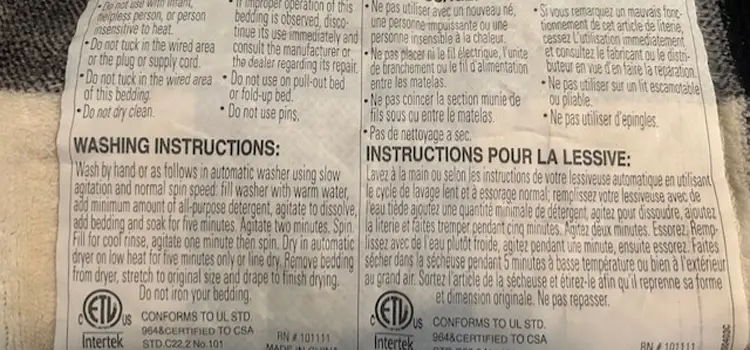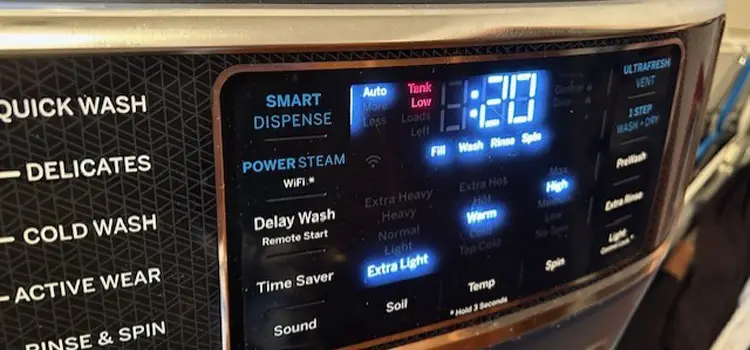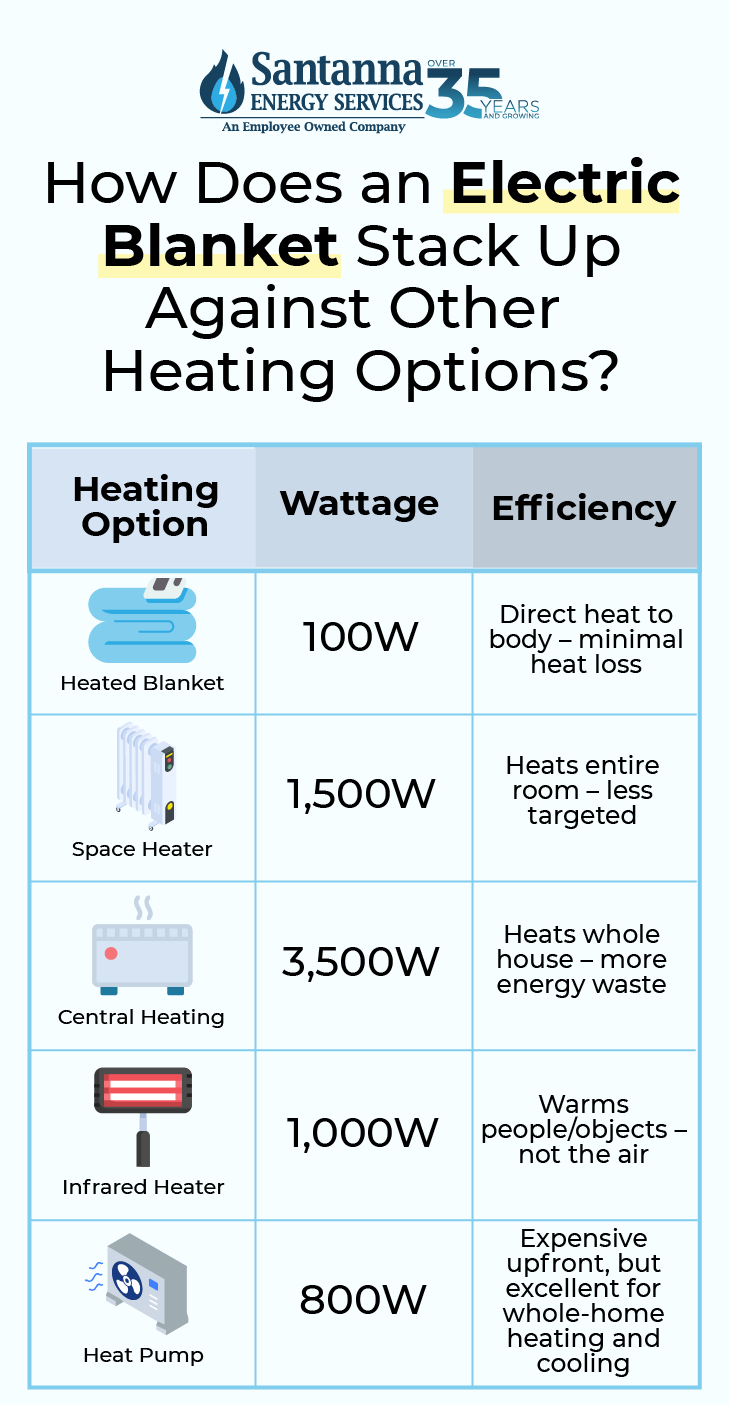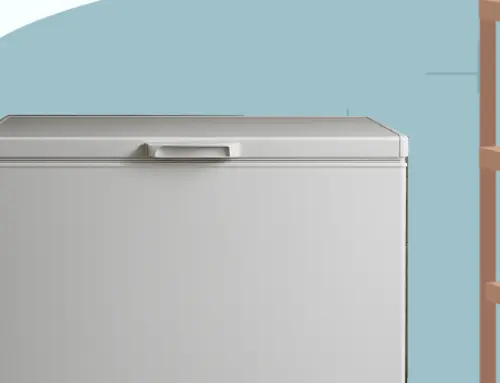Can You Wash an Electric Blanket? Plus Energy Costs and More
by Tyler Castle
22.4 min read

Electric blankets have become a cozy staple for many households, offering warmth and comfort during chilly nights. But as with any bedding item, they require regular cleaning to stay fresh and hygienic. If you've ever wondered whether washing your electric blanket is safe—or if it might ruin the heating elements—you're not alone. Many people hesitate to throw their electric blankets (also referred to as heated blankets) into the washing machine, fearing damage or malfunction.
In this guide, we'll answer all these questions and more. We'll explore the best ways to clean your electric blanket, how much energy it uses, and key tips for maintaining it properly. Whether you're looking to extend the lifespan of your blanket or simply make sure you're using it efficiently, this blog has you covered. Let's dive in!
What Is an Electric Blanket?
An electric blanket is a specially designed blanket with built-in heating elements that generate warmth when plugged into an electrical outlet. These blankets use thin, insulated wires or carbon fiber heating elements woven into the fabric to evenly distribute heat.
Electric blankets come in different sizes and styles to suit various bed sizes and personal needs. They are commonly available in single, double, queen, and king sizes, so it’s important to choose one that provides the right coverage for your bed.
There are also different types of electric blankets to choose from! Underblankets are made to be placed on top of the mattress and secured with an elastic skirt to stay in place while over-blankets are used over your regular bedding for extra warmth. Duvet-style blankets are designed to function as a standalone heated blanket with a separate controller.
How Do Electric Blankets Work?
Electric blankets work by using thin, insulated wires or heating elements that run through the fabric. When the blanket is plugged into a power outlet and turned on, electricity flows through these wires, creating resistance, which in turn produces heat. This warmth is then evenly distributed across the surface of the blanket, creating a cozy and consistent temperature.
Most electric blankets come with a control unit —often detachable—that allows you to adjust the heat settings to your preferred comfort level. Some models offer dual-zone controls so that each side of the blanket can be set to different temperatures, making them great for couples with varying heat preferences.
Modern electric blankets also come with built-in safety features, such as automatic shut-off timers and overheat protection sensors. These features not only help conserve energy but also enhance safety, especially when used overnight.
Can You Wash an Electric Blanket?
You can wash most electric blankets. Modern electric blankets are designed to be machine-washable, with insulated wiring that can withstand gentle cleaning cycles. However, older models or certain high-end versions may require hand-washing only to maintain their functionality.
The key concern when washing an electric blanket is preventing damage to the internal wiring. Submerging it in water for too long, using harsh detergents, or exposing it to high heat can weaken the electrical components. Most manufacturers recommend using a mild detergent and a gentle wash cycle to keep the blanket clean without compromising safety.
When wondering if you can wash an electric blanket, many people worry that washing an electric blanket could lead to electrical hazards, but as long as the blanket is completely dry before being plugged in, and you don’t wash the cord that comes with the blanket, it’s safe to use. Proper care can also extend the lifespan of the blanket, ensuring it remains warm and effective for years to come.
What Is the Best Way to Wash an Electric Blanket?
The best way to wash an electric blanket is to follow the manufacturer’s care instructions. Generally, modern electric blankets can be machine-washed using a gentle or delicate cycle with cool to warm water and a mild detergent.
Avoid using bleach or fabric softeners, as they can damage the blanket’s internal wiring. After washing, it’s recommended to air-dry the blanket by laying it flat on a drying rack something parallel.
While you can dry your electric blanket in the dryer, it’s generally recommended to dry at a low heat and only for a few minutes and to let the blanket dry naturally.
Materials Needed to Wash an Electric Blanket
Washing an electric blanket is a simple process. Most electric blankets will come with their own washing instructions since each brand of blanket is different. But in the case your model doesn’t come with specific instructions; to wash your electric blanket, you’ll typically need the following materials:
- Mild detergent: Choose a gentle laundry detergent free from bleach and fabric softeners to protect the blanket’s wiring.
- Washing machine or large basin: Depending on the manufacturer’s instructions, you may use a washing machine or hand-wash the blanket in a bathtub or large sink.
- Drying rack or clothesline: For air-drying the blanket flat to maintain its shape and prevent damage to internal components.
How to Clean an Electric Blanket in a Washer
Before washing, read the manufacturer’s instructions on the care label to ensure the blanket is machine-washable and to determine the recommended settings. If you don’t have specific written instructions, start by disconnecting and unplugging the blanket and detach any controllers or cords.
Be sure to inspect the blanket for visible damage, such as exposed wires or scorch marks. If you see any of these, do not wash your blanket in a washer as this could ruin and break the electrical function of your blanket.
If there are stains, apply a small amount of mild detergent directly to the affected areas and gently blot with a clean cloth to remove them. For most washing instructions, the cycle length and settings recommended for washing an electric blanket won’t be enough to fully remove stains.
Next, set your washer setting and place the blanket loosely in the washing machine to allow for proper movement during the cycle. Use a gentle or delicate cycle with cool to warm water and add a mild detergent. Avoid bleach and fabric softeners, as they can damage the blanket’s internal wiring. After washing, gently squeeze out excess water without wringing.
How to Clean an Electric Blanket by Hand
Confirm that hand-washing is recommended by the manufacturer by reading the care instructions. Hand washing your electric blanket is the most recommend method for blanket brands.
Like with washing your blanket in the washer, be sure to unplug the blanket and remove any controllers or cords. Check for visible damages, such as exposed wires or scorch marks and cover any exposed areas you may see as a safety to avoid electrical shock when prewashing stains.
For bigger stains, apply a small amount of mild detergent to any stained areas and gently blot with a clean cloth. To wash your entire blanket, fill a bathtub or large basin with lukewarm water and add a small amount of mild detergent, mixing it to create a soapy solution.
Submerge the blanket in the soapy water and let it soak for 10 to 15 minutes. Gently agitate the blanket by hand to clean it, avoiding twisting or wringing, which can damage the internal wiring.
After 10-15 minutes, drain the soapy water and refill the basin with clean water. Rinse the blanket by gently pressing out the soapy water. Repeat this process until all detergent is removed.
Can You Dry an Electric Blanket?
Yes, you can dry an electric blanket, but it’s essential to follow proper guidelines to maintain its functionality and ensure safety. Air-drying is the safest method when it comes to drying an electric blanket. Lay the blanket flat on a drying rack or clothesline, ensuring it’s evenly supported to prevent stretching. Allow it to air dry completely before reconnecting any power components.
Some electric blankets are designed to withstand machine drying. If the manufacturer’s instructions permit, use a low-heat or air-dry only setting on your dryer. Avoid high heat, as it can damage the internal wiring. It’s advisable to partially dry the blanket in the dryer for about 20 minutes and then remove it while it’s still damp to finish air-drying.
Keep in mind that excessive heat can damage the blanket’s wiring and insulation. Before plugging in and using the electric blanket, make sure it’s thoroughly dry to prevent electrical hazards. Wait at least overnight to make sure your sheet is completely dry.
Here’s How We Washed Our Electric Blanket
To help you solve if you can wash an electric blanket, we’ve done the work for you! Our Senior Digital Marketing Assistant, Jenna, has the scoop on how she washed her electric blanket:
For this process, I washed a black and white Biddleford Blanket following these washing instructions printed on the blanket itself:
”Wash by hand or as follows inan automatic washer using slow agitation and normal spin speed. Fill washer with warm water, add minimal detergent and soak for five minutes. Agitate gently for two minutes. Spin. Fill for cool rinse. Agitate one minute. Spin. Dry in automatic dryer five minutes on low heat or air dry. Remove from dryer, stretch to original size and drape to finish drying.”
Note that all electric blanket washing & drying instructions are different, and exact instructions will vary by brand.

Here is a photo of the blanket we’re cleaning and the detergent I used during this cleaning process.

I used this brand from Costco (Suavitel) and only used about 2 tablespoons of detergent to wash this blanket. Before I washed this blanket, I of course, unplugged the cord from the blanket and checked for frays in wires before cleaning. I checked the blanket again for bigger stains, I was planning on doing some spot cleaning before the full wash, but the blanket didn’t have any.

Before I started the cycle, I used around two tablespoons of detergent. The instructions for cleaning this blanket stated using a cycle with warm water and washing the blanket for 10 minutes on a slow cycle would do the trick to wash it.
My washer doesn’t have a “set your time” setting on it so, I set it for quick wash, with warm water and monitored the cycle for 10 minutes and took the blanket out.

The blanket was still pretty wet so I lightly squeezed the water out before putting it into the dryer. I set my dryer to 10 minutes and applied low heat to dry out my blanket.

After drying, I spread the blanket out on a parallel surface to air dry. As a safety for the wiring I left my blanket out to dry for 48 hours instead of 12. After that period, the blanket is working well and smells great! So, yes, you can wash an electric blanket!
How Often Should You Wash a Heated Blanket?
You should wash your heated blanket every two to four weeks if used regularly, especially during colder months. This helps maintain cleanliness by removing sweat, body oils, and dust. If you only use the blanket occasionally, washing it once per season may be sufficient.
For people with allergies or sensitive skin, more frequent washing (every one to two weeks) can help reduce allergens like dust mites and pet dander. To minimize wear and tear, consider spot-cleaning small stains between washes instead of doing a full wash cycle every time. Always follow the manufacturer’s cleaning guidelines to prevent damage and extend the lifespan of your electric blanket.
Common Mistakes to Avoid When Washing an Electric Blanket
Proper cleaning of your electric blanket ensures longevity and safety. Because electric blankets are considered an electric appliance, avoid these mistakes when washing:
- Always wash your electric blanket in cool or warm water. Hot water can damage the internal wiring and insulation.
- Opt for a gentle or delicate cycle to prevent unnecessary agitation that could harm the heating elements.
- Avoid dry cleaning electric blankets unless specified by the manufacturer, as dry-cleaning chemicals can deteriorate wire insulation.
- Do not wring or twist the blanket. Instead, gently squeeze out excess water and air-dry or use a low-heat dryer setting.
- Always consult the care label for specific washing and drying guidelines to prevent damage and perform any other step you might have missed.
Do Electric Blankets Use a Lot of Electricity?
Compared to other appliances in the home, electric blankets do not use a lot of electricity compared to other heating options. They are designed to be energy-efficient, typically consuming 50-200 watts per hour.
Unlike space heaters, which can use 750 to 1500 watts per hour, electric blankets focus heat directly on the user rather than warming an entire room. This targeted heating approach reduces overall power consumption while still providing effective warmth.
Additionally, many modern electric blankets come with adjustable heat settings and automatic shut-off features, allowing users to optimize energy use by lowering the heat level once the bed is warm or setting a timer to turn off after a few hours.
In short, an electric blanket doesn’t use a lot of electricity as long as you use it strategically, such as preheating the bed before sleep to further help minimize electricity usage. Compared the second best targeted heating alternative (the space heater), a heated blanket burns 1.3 kWh less electricity per hour.
Electricity Consumption of an Electric Blanket Compared to Other Appliances
Electricity Consumption of an Electric Blanket Compared to Other Appliances
| Appliance | Average Wattage | Hours | Daily Kilowatt-hour (kWh) consumption |
|---|---|---|---|
| Electric Blanket | 100 | 2 | 0.2 |
| Television (LED, 54.4-inch – 57.5 inch) | 93 | 10 | 0.93 |
| Refrigerator | 250 | 24 | 6 |
| Microwave | 1500 | 1 | 1.5 |
| Microwave | 1800 | 1.5 | 2.7 |
| Central Air Conditioner | 4000 | 24 | 96 |
| Central Air Conditioner | 1500 | 8 | 12 |
| Laptop | 100 | 10 | 1 |
How Many Watts Does an Electric Blanket Use?
Electric blankets typically operate at 50-200 watts per hour, making them low-energy devices. When used efficiently, their electricity consumption remains minimal. Typically, up to1.3 amps are used in an electric blanket and in the U.S., electrical outlets provide 120 volts, which is enough to power most household appliances.
How Much Electricity Does an Electric Blanket Use?
Electric blankets are designed to be energy-efficient, using only a small amount of electricity per day. If an electric blanket operates at 100 watts (0.1 kW) and is used for 30 minutes before bed, it would consume just 0.05 kWh per day.
Over the course of a month, this adds up to about 2 kWh, which is a very low amount of electricity compared to appliances like a space heater and central heating. This makes electric blankets a cost-effective way to stay warm without significantly increasing energy usage.
Here's how to determine the how many kilowatt-hours of electricity an electric blanket uses:
- If you don't have your wattage on your packaging label, you can find your blanket's wattage by multiply the voltage by the amperage to get the wattage. Let's say for our example, we have 120 volts and 1.3 amps — 120 volts x 1.3 amps = 100 watts.
- Divide the wattage by 1,000 (the amount of watts in one kilowatt-hour) — which for our example is 100/ 1,000 = 0.1 kWh
- Then multiply your estimated kilowatt-hours by the amount of time you plan on using your blanket in a day. It's recommended you use your electric blanket for 15-30 minutes before going to bed but let's set the maximum usage per day to 30 minutes in this example: 0.100 kWh x 0.5 hour = 0.05 kWh per day.
So an electric blanket at 100 wattage of power used for 30 minutes a day will use 0.05 kWh of electricity.
Here's how much electricity an electric blanket will use per week, month and year if you use it for 30 minutes each day:
How Much Electricity an Electric Blanket Uses Per Day, Week, Month & Year (30 Minutes a Day)
| Time Period | Hours Used | Electricity Used (kWh) | Cost ($0.1790 per kWh) |
|---|---|---|---|
| Per Day | 0.5 | 0.05 | $0.009 |
| Per Week | 3.5 | 0.35 | $0.06 |
| Per Month | 15 | 1.5 | $0.27 |
| Per Year | 182.5 | 18.25 | $3.27 |
How Much Does It Cost to Use an Electric Blanket?
Electric blankets come in many sizes and wattages. To find out how much the electricity consumption of your electric blanket will cost you, take the cost of your electricity rate (these rates vary from state to state); the U.S. average is 17.90¢ per kWh and multiply it by how often you'll use your blanket per day. After you've found this estimate, simply multiply it by the amount of days in a week, month, and year you plan to use it.
Below is an estimate at 17.90 cents per kWh how much different electric blankets will cost you:
Cost to Use an Electric Blanket By Size Per Day, Week, Month, Year (at 17.90 cents per kWh)
| Blanket Size | Wattage (W) | For 1 day (30 minutes) |
For 1 week (7 days) |
For 1 month (30 days) |
For 1 year (365 days) |
|---|---|---|---|---|---|
| Small (Twin) | 50 | $0.004 | $0.031 | $0.134 | $1.63 |
| Medium (Full/Queen | 80 | $0.007 | $0.050 | $0.215 | $2.61 |
| Large (King) | 120 | $0.011 | $0.075 | $0.322 | $3.92 |
Electric Blanket vs. Space Heater and Other Heating Alternatives
When it comes to staying warm during colder months, an electric blanket can be a highly efficient and cost-effective solution. Here's how a heated blanket stacks up against the rest:
Comparing How Much Electricity a Heated Blanket Uses Compared to Other Heating Alternatives
| Heating Option | Average Wattage | Estimated kWh per Hour | Estimated Cost per Hour* | Estimated Monthly Cost (8 hrs/day) | Efficiency Notes |
|---|---|---|---|---|---|
| Electric Blanket | 100W | 0.1 kWh | $0.02 | $4.29 | Direct heat to body; minimizes heat loss |
| Space Heater | 1,500W | 1.5 kWh | $0.27 | $64.44 | Heats entire room, less targeted |
| Central Heating | 3,500W | 3.5 kWh | $0.63 | $150.48 | Heats entire house, more energy waste |
| Infrared Heater | 1,000W | 1.0 kWh | $0.18 | $42.96 | Heats objects/people directly, not the air |
*Based on an average electricity rate of 17.90¢ per kWh
At around 100W of electricity, electric blankets use significantly less energy than space heaters or central heating. Electric blankets aim to warm your body directly rather than heating the air, which minimizes energy waste.
If you're wondering if it's cheaper to use an electric blanket than actual heating, running an electric blanket for 8 hours a night costs roughly $4.29 per month—much cheaper than a space heater or central heating.

Are Electric Blankets Safe?
Electric blankets are generally safe when used correctly and maintained properly. Modern electric blankets come with built-in safety features such as auto shut-off, overheat protection, and temperature control settings to reduce risks. However, like any electrical appliance, misuse, wear and tear, or manufacturing defects can pose safety concerns.
To ensure safety with your electric blanket, always follow the manufacturer's guidelines for use, cleaning, and storage. Be sure to regularly inspect your blanket for any signs of damage or malfunction and avoid using electric blankets on infants, elderly individuals with reduced heat sensitivity, or people with certain medical conditions (such as diabetes or nerve disorders).
Lastly, never leave an electric blanket on overnight unless it has an auto shut-off feature to prevent overheating.
Electric Blanket Dangers To Be Aware Of
While electric blankets are designed for safe use, certain risks should be considered. Overheating while using an electric blanket is one of the most common dangers. This is especially risky for individuals with reduced heat sensitivity, such as the elderly or people with nerve damage. Be sure you don't fall asleep while using an electric blanket to avoid this danger.
Internal wiring can become damaged over time, leading to electrical malfunctions, sparks, or fire hazards. This can lead to burns on your skin, damage to your outlets, and even house fires. Bending, creasing, or tightly folding the blanket can break or damage the heating elements inside as well.
A frayed, twisted, or exposed power cord is a major safety concern. It can cause electrical shorts, sparks, or even fires if plugged in. Never run the cord under a mattress or heavy objects, as this can weaken the insulation and increase fire risks. Be sure to unplug your blanket before leaving the room to minimize this risk.
Lastly, some users may experience burns if the blanket is left on high heat for too long or pressed too closely against the skin. It is recommended that children, pregnant individuals, and people with diabetes or circulation problems refrain from using electric blankets. Opt for low-voltage or battery-operated blankets for peace of mind.
Why Is My Electric Blanket Not Working?
If your electric blanket isn't functioning correctly, consider the following troubleshooting steps:
- Check the Power Connection: Ensure the blanket is securely plugged into a working outlet. Test the outlet with another device to confirm it's supplying power.
- Inspect the Controller: Verify that the control unit is properly connected and set to the desired temperature. If it's unresponsive, try resetting it by turning it off and then on again.
- Examine for Physical Damage: Look for signs of wear, such as frayed wires, scorch marks, or damaged fabric. If you notice any of these issues, discontinue use immediately.
- Consult the Manufacturer's Manual: Refer to the user manual for specific troubleshooting advice related to your blanket's model.
- Contact Customer Support: If problems persist, reach out to the manufacturer's customer service for assistance, especially if your blanket is still under warranty.
If your problem still persists after checking all these common issues, it's best to retire your blanket and opt for a new one.
How Do I Know When to Throw Out an Electric Blanket?
Like any appliance, electric blankets too ware out over time and need to be replaced. While it might be hard to determine when it's time for a change, recognizing the signs that indicate it's time to replace your electric blanket is crucial for safety and optimal performance. Replace your blanket if…
- Your blanket is over 10 years old. Electric blankets older than 10 years are more prone to electrical shorts and other issues. It's advisable to replace them to ensure safety.
- Your blanket has a lot of wear and tear. Inspect your blanket regularly for fraying fabric, scorch marks, or exposed heating elements. Such damages can pose significant safety hazards and warrant immediate replacement.
- The controller emits buzzing sounds, produces unusual odors, or operates erratically, it may indicate internal faults. Replacing the blanket is recommended in such cases.
- You experiencing excessive heat beyond the set temperature suggests a malfunction, necessitating discontinuation of use and replacement.
- You experience frequent tripping of circuit breakers or blown fuses when using the blanket indicates potential electrical problems, signaling the need for a new blanket.
Tips for Maintaining an Electric Blanket
Proper maintenance can extend the lifespan of your electric blanket and ensure safe and efficient use. Here at Santanna, we always want you to be safe and keep your appliance around for the long run. Follow these best practices to keep your electric blanket functioning:
- Regular Inspection: Before each use, examine the blanket for any signs of damage such as frayed wires, burn marks, or loose connections and check the power cord and controller for wear or malfunction. If you notice any unusual smells, sparks, or inconsistent heating, stop using it immediately.
- Follow Cleaning Instructions: Always follow the manufacturer's washing guidelines—some blankets are machine-washable, while others require hand-washing only. Misreading or mishandling your blanket can lead to damage and early unneeded replacement.
- Avoid Creasing and Folding: Keep the blanket flat and evenly spread when in use to prevent overheating when possible. Do not fold, roll, or bunch up the blanket while it is turned on, as this can cause hot spots and damage the internal wiring and cause burns on your skin.
- Practice Proper Storage: Store your blanket in a cool, dry place away from moisture, extreme temperatures, or direct sunlight. Avoid placing heavy objects on top of the blanket to prevent wiring damage and if possible, use a breathable storage bag (like cotton or fabric) instead of plastic to prevent moisture buildup.
- Use a Surge Protector: The last thing you want is a power outage that's caused by your heated blanket. Plug the blanket into a surge protector rather than directly into the wall, especially in areas prone to power fluctuations as this can help protect against sudden voltage spikes and power surges in bad weather.
- Set a Timer and Use Auto Shut-Off Features: If your blanket has a timer or auto shut-off feature, take advantage of it to prevent overheating and extend the blanket's lifespan. Avoid using an electric blanket all night—instead, preheat your bed and turn it off before sleeping.
- Use with the Right Voltage: Ensure that your blanket matches the electrical voltage of your country (e.g., 120V in North America, 220V in Europe). Using the wrong voltage can damage the heating elements.
FAQs
Is my electric blanket machine-washable?
To determine if your electric blanket is machine-washable, check the care label attached to the blanket. This label provides specific washing instructions from the manufacturer. If the label indicates that machine washing is safe, you can proceed with washing it in your machine. If the label is missing or unclear, consult the manufacturer's website or customer service for guidance.
As a rule of thumb, it's better to assume it's not to avoid damage to your blanket. Instead, spot clean with laundry detergent and air dry.
Will machine washing ruin an electric blanket?
Most modern electric blankets are designed to withstand machine washing. However, it's crucial to follow the manufacturer's care instructions to prevent damage. Typically, this involves using a gentle cycle with cold water and mild detergent, and avoiding high heat during drying. Improper washing can harm the internal wiring, so adherence to guidelines is essential.
Is it dangerous to use an electric blanket on pet beds?
Using standard electric blankets on pet beds is not recommended. Pets' claws and chewing habits can damage the blanket, exposing wiring and increasing the risk of electric shock or fire. Instead, opt for heated pet beds specifically designed with safety features suitable for animals.
Is it worth getting an electric blanket?
An electric blanket uses less energy than heating an entire room because it warms only your bed. This helps save electricity and lets you control your own warmth without affecting others in the house. However, if your home is very large or not well insulated, an electric blanket might not be enough to keep you warm, and using low-level heating overnight could be a better option.
Electric blankets are a safe, cost-effective, and energy-efficient way to stay warm during colder months, provided they are used correctly and maintained properly. By following proper care guidelines, regular inspections, and safe usage practices, you can extend the lifespan of your electric blanket while ensuring your safety.
While an electric blanket helps you stay warm at night, your home's overall energy plan plays a big role in managing heating costs year-round. If you're looking for a competitive and reliable energy supplier, Santanna Energy Services offers innovative energy plans that keep your home comfortable in every season. Explore Santanna's energy plans today and find the best option for your home!
Tyler is an experienced energy professional, having worked for Santanna Energy Services, for the past four years. He is passionate about renewable energy and believes that diversifying the energy grid is the key to a sustainable future. Tyler is dedicated to supplying consumers with the best possible energy solutions and works diligently to make sure that Santanna can deliver the highest quality service.







